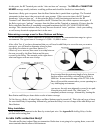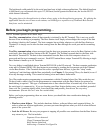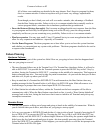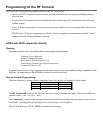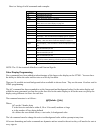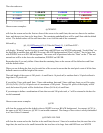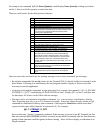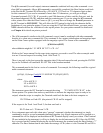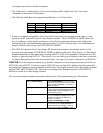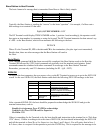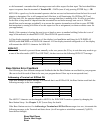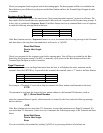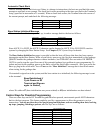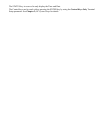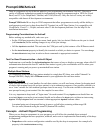
The @S command (for serial output) statement cannot be combined with any other command - even
clear (@Cx) commands. After a @S command is successfully completed, the Base Station sends back
to the host the RF Terminal ID followed by a CR (ASCII 13). There is a 231 character limit on data
for this command. If you send a command of more than 231 characters, you will get an Illegal
Command returned, (ID ? CR). If you need to send 300 characters of data, send the first part, wait for
the acknowledgement (ID CR), and then send the remaining part. If you are using the @S command
with a printer other than the Zebra Cameo or QL3, you may have to change the Protocol parameter in
the RF Terminal to XON/XOFF. This will allow the RF Terminal to deal with the character buffer
limitations of your particular printer. If you are using the O’Neil MicroFlash Printer, you must send a
NULL character before the valid data to wake up the printer. See your printer manual for details and
see Chapter 6 for details on printer protocol.
• The @M command is similar to the @S command, except it can be combined with other commands
because it is a data entry command too. This command is for a printer initialization and magstripe input
on the Zebra Cameo printer equipped with the magstripe option. The format of the command is:
@Mdddatttta(EOT)
where dddatttta might be ! U1 MCR 80 T1 T2+ CR + LF
(Refer to the Cameo manual for the exact string sequence you need to send. The above example sends
over an 10 second request for reading Track 1 and Track 2).
There is no reply to the host except the magstripe data. If the card cannot be read, pressing the ENTER
key on the Terminal will send back ID+CR. This is the breakout method.
This command must be the last in a series of commands. For example, the following would be a typical
multi-command statement:
@C0@1,1,0,Swipe Card@M! U1 MCR 80 T2 (CR)(LF)(EOT)
where:
CR is ASCII 13
LF is ASCII 10
EOT is ASCII 4
The statement causes the RF Terminal to transmit the string "!U1 MCR 80 T2 CR LF" to the
Cameo printer. The printer then wakes up and blinks to indicate the magstripe input is ready to be
swiped; when the swipe is complete, the Terminal sends back the data to the host computer as:
ID+T2:Data on Card+CR (the printer's CR LF stuff is stripped)
If the request is for Track 1 and Track 2, the data sent back is
ID+T1:data on 1+T2:data on 2+CR
• Every statement must end with a data entry “prompt” command, whether the statement is a single
command by itself or several commands combined together. Any illegal statement will be ignored as a
command but will be displayed on the addressed RF Terminal display exactly as written. If no Terminal
ID was included in the statement, it will try to display the invalid statement on ID 0. Once the ENTER
key is pressed on the Terminal displaying the invalid statement, the terminal sends the Base Station a “?”
character. The Base Station then in turn sends the message n?CR (where n is the Terminal ID and CR is



